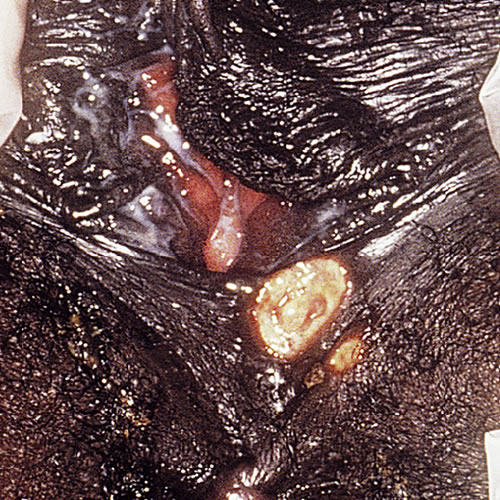Introduction
Chancroid1 is an acute sexually transmitted disease that causes a very painful ulcer and suppurative regional lymphadenopathy. Synonyms for chancroid include soft chancre, chancre mou, and ulcus molle.
Epidemiology
Chancroid usually affects young adults and is most common in tropical and subtropical climates. It is responsible for up to 60% of genital ulcers in Africa and Asia but is relatively rare in the United States. In 2013, a total of 10 cases of chancroid were reported in the United States. Only 4 states reported one or more cases of chancroid in 2013. 2
Etiology
Chancroid is caused by Haemophilus ducreyi, a gram-negative streptobacillus.
Symptoms and clinical features
After contact with an infected individual, a painful ulcer develops 4 to 7 days later, and a painful, unilateral, inguinal lymphadenitis occurs 1 to 2 weeks later in up to 50% of patients. Sometimes the ulcers can be present for months with little to no symptomatology.
The first sign is a papule on the vulva in the area of the labia, posterior commissure, or vestibule. This becomes pustular and ulcerates. The ulcer has a grayish surface, an irregular border, and surrounding erythema. One third of patients may have multiple lesions.

The associated lymphadenopathy may progress in 50% of patients to bubo formation and may rupture, yielding a chronic sinus. Without treatment, the ulcer lasts about two months and then heals, leaving scars behind; ulceration and drainage from enlarged lymph nodes can take longer to heal.
Diagnosis
Diagnosis is by clinical presentation. The organism can be cultured on selective media.
Pathology/Laboratory Findings
A smear of the ulcer reveals the typical short, plump, gram negative rods, often in streptobacillary chains. These are found in clusters outside the white cells, looking like a “school of fish.”
HIV testing should be considered in patients with vulvar ulcerations.
Differential diagnosis
Herpes simplex, syphilis, granuloma inguinale, lymphogranuloma venereum, and trauma.
Treatment/management
Drugs prescribed include:
- Azithromycin 1 g orally once
- Ceftriaxone 250 mg IM once
- Ciprofloxacin 500 mg orally twice a day x 3 days
- Erythromycin base 500 mg orally three times a day x 7 days
Healing of the ulcers usually takes place within a week but lymph node changes take longer and may require incision and drainage or needle aspiration.
For the most up to date information on chancroid, visit the CDC website: www.cdc.gov/std/general.
References
- Fisher BK, Margesson, LJ. Genital Skin Disorders: Diagnosis and Treatment. Mosby, Inc., 1998.145-146.
- http://www.cdc.gov/std/stats13/other.htm